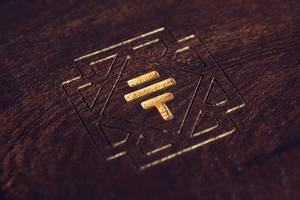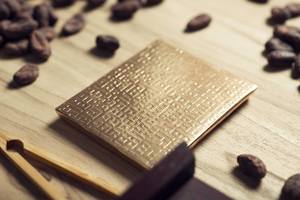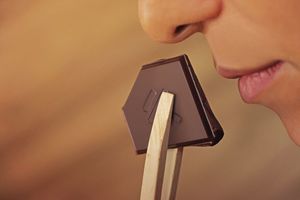In 2014 a brand-new maker called To’ak took the world by surprise with a $260 bar of chocolate. Now they’ve upped the ante, with a $345 bar that has been aged for 18 months in a Cognac cask (it comes in the same expensive-looking wooden box with gold lettering and handmade tweezers as the first bar). Most makers are having trouble convincing the crowd that they should pay $10 for a bar of chocolate. So is a $325 bar helping or hurting the bean-to-bar cause? And at the end of the day, is the chocolate worth it, or is it simply marketing and hype, otherwise known as (necessary) bullshit?
Pros
When I tried the $260 bar last year with co-founder Jerry Toth, I was pleasantly surprised:
“The chocolate itself is great, single-origin Nacionale cacao from Ecuador that Jerry and his team have clearly taken a lot of time to cultivate. He described the aroma as ‘a flowerpot in the face,’ which I thought was pretty accurate.”
— Chocolate Noise, Facebook, Nov. 9, 2015
I haven’t tried the $345 bar, but something tells me it’s equally interesting. I believe that a crazy-high price like this is ultimately good for the industry, as it forces people to challenge their assumptions that chocolate is a cheap thrill without much depth or nuance to the flavor.
Here’s what Lauren Adler, the owner of Seattle specialty store Chocolopolis, had to say:
“The media attention they receive from their $345 bar of chocolate will be a good thing for the craft chocolate industry in the long term. Why? It forces consumers to think about chocolate in the same way they think about wine, cognac or other expensive liquors. Consumers aren’t used to paying the true economic cost of their chocolate. Suddenly, a craft chocolate bar that costs $14.00 seems like a good buy. ”
— Lauren Adler, Chocolopolis
Meanwhile Jessica Ferraro of Bar Cacao said in some ways she sees it as a positive because "it's been way easier to work with a $12 bar and a $20 bar since To'ak's release." She also mentioned how transparent Jerry is about the company’s process and goals, which has been my experience as well.
Cons
Yet at the end of the day, Jessica said she believes To’ak is more problematic than progressive, because it’s too easy to poke holes in what the company is doing. Through conversations with Jerry, she learned that the $260 bar was the company’s first attempt at making chocolate, and that the $325 bar is their first and only attempt at aging chocolate (in a Cognac barrel or Elm barrel, depending on which bar you buy). In fact, the aged chocolate is repurposed from the first time they made chocolate: Reject bars were remelted into one-gram-size coins and dropped into the barrels.
“It’s problematic to make your first batch of chocolate, put it out there to the world and suggest that it’s worth this much money because that is what it costs to produce.
A bar this expensive should be made by someone with expertise and experience. They are gaming it. They hired two people to help them. They did go to the rainforest of Ecuador and uncover some good cacao and are working to save it, but they’re being very provocative.”
— Jessica Ferraro, Bar Cacao
The bigger problem to me, though, is that there's no concrete evidence that aging chocolate makes it any better (to some degree, all chocolate is aged, since it takes time to get it from the factory to your mouth). To'ak even quotes Mark Christian from the C-Spot in their own pamphlet on this issue:
“Theoretical and anecdotal evidence suggest that allowing a bar to mature under climate-controlled settings softens flavor tags and rounds off the sharp spikes and edges, mellowing the overall profile. What else the aging process might do — whether bringing greater concentration or added hues to the flavor graph — currently remains speculative for aging chocolate.”
— Mark Christian, C-Spot
To’ak is getting press from places like Vice’s Munchies, which highlights the high price they pay their farmers and their profit-sharing program. That’s great, as it sheds light on direct trade and bean to bar. However, they’re hardly the only makers to do this. Taza, Askinosie, Dandelion, Patric, French Broad — the list of makers paying high prices, trading directly, and caring intensely about farmers and the quality of cacao goes on and on. In fact, it’s a hallmark of this new movement, not something unique to To’ak. And you can buy those bars for about $8.50. So what makes this one worth $325?
Lauren wondered that as well:
“I’m looking at the money To’ak spent on packaging, website development, marketing, a 116-page booklet, an engraved wood box and a very old Cognac barrel, and I can see the costs adding up quickly. The small batch of only 100 bars produced has some expensive marketing behind it.”
— Lauren Adler, Chocolopolis
Meanwhile Clay Gordon of TheChocolateLife.com said, "I'm not convinced that the bars would sell without the gimmicks — the box, the tweezers, etc." Instead he recommended the seven-bar Heirloom Cacao Project sampler from the C-Spot, which is priced at a comparably low $100.
So after all this discussion, should you pay for someone’s experiment? Or, if the chocolate is great, does it matter? What’s the highest price that makers should charge for a bar of chocolate, regardless of how much work went into it?
Sure, To’ak raises plenty of questions. But in my mind it’s not a cut-and-dried good or bad thing, because they’re questions we need to be asking.
Agree? Disagree? Tell me what you think at megan@chocolatenoise.com or on Facebook or Twitter and I'll include your comments in the next Chocolate Today!
Read More Stories!
Askinosie: It's Not About the Chocolate, It's About the Chocolate




